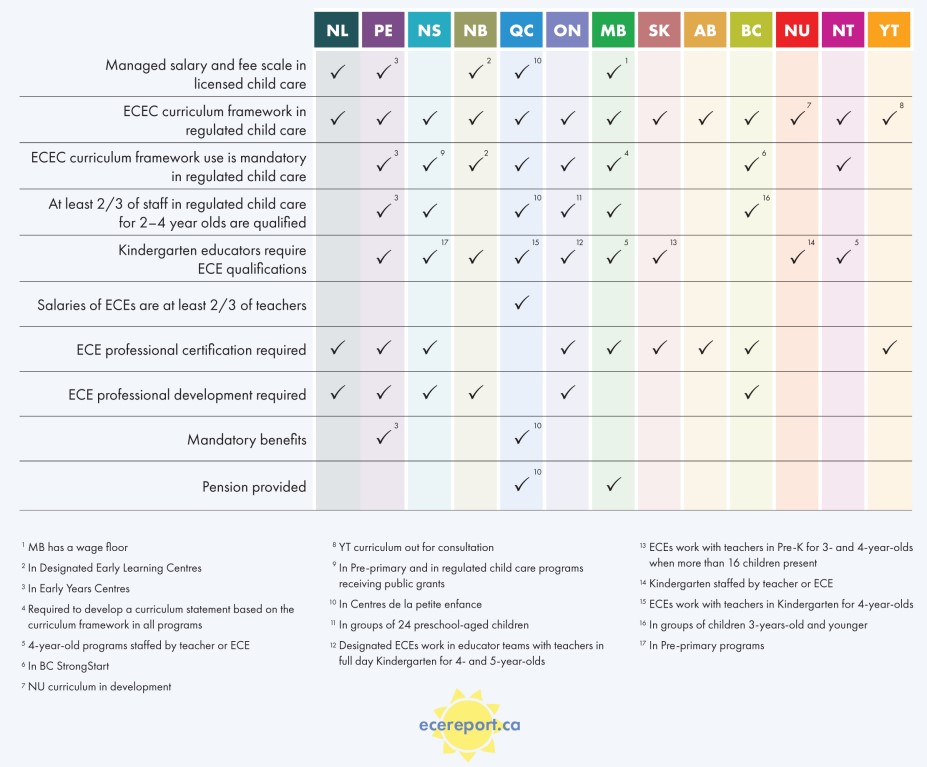
An Investment that Works for Child Care
Expanding the child care workforce nationwideBy Jessica Lue and Katie Davey
Introduction
More than 50 years after the first reference to a national child care program appeared in the Royal Commission on the Status of Women, Budget 2021 committed $30 billion over five years to achieve a child care system that offers an average charge to parents of $10 a day. Today, every province and territory has signed a bilateral agreement with the federal government to deliver on such a program and progress is being made quickly to make high-quality child care more affordable, inclusive and accessible. Against the backdrop of these milestone investments, calls for early childhood workforce support persist.
In May 2021, the Public Policy Forum, in partnership with YMCA Canada, released From Investment to Action: Building a Canada-wide Child Care System. One of the key recommendations of the report was to “develop and fund a comprehensive, national early learning and child care workforce strategy informed by labour force trends.” The rationale for this recommendation was simple.
The child care workforce is the key factor of high-quality child care and, as such, early childhood educators are the linchpin of the entire system.
We heard confirmation of this reality repeatedly throughout our discussions with experts.
This second report builds on the work to date and takes a deeper dive into the recommendation on workforce development. The report outlines elements of workforce development that can be implemented now and within the structure of the bilateral agreements between individual provinces/territories and the federal government. It looks at what can be done to improve workforce recruitment, retention, recognition, training and retraining with an eye toward building capacity within the sector. There are structural elements of the existing child care system across Canada that form a barrier to workforce expansion and much research exists on each of them, including funding models, public, non-profit, and private care and worker representation with the sector. These require careful consideration but are beyond the scope of this paper. Accompanying this paper, we released a series of provincial, territorial, and Indigenous snapshots on workforce development representing each region. Through interviews and a roundtable discussion hosted on March 24, 2022, the report was informed by experts, advocates and practitioners.
While this report is informed by a snapshot written on the general perspective of Indigenous child care, it is clear from our consultations, and consultations beyond this report, that any movement on improving the Indigenous child care sector and workforce must be done with Indigenous Peoples. We urge all orders of government to engage meaningfully together in this dialogue.
We’d like to highlight the work done by the Atkinson Centre, specifically its Early Childhood Education Report, which is released every three years and tracks provinces and territories on 21 benchmarks, including a number related to workforce. We’d also like to recognize the centre’s recently released report Canada’s Children Need a Professional Early Childhood Education Workforce, which provides a detailed comparative analysis of each province and territory on various workforce metrics.

The Child Care Workforce
High-quality Care
An early learning and child care system should be four things: accessible to all who want to access it; affordable to any family; inclusive of all children in their various dimensions of diversity; and it should provide a safe and high-quality learning environment for all children.
High-quality child care largely comes down to the people delivering early learning and child care (ELCC). Harvard University’s A Science-Based Framework for Early Childhood Policy offers the following definition of quality in centre-based child care programs:
Centre-based programs that have positive impacts on young children’s development provide some combination of the following features:
- Highly skilled staff;
- Small class sizes and high adult-to-child ratios;
- A language-rich environment;
- Age-appropriate curricula and stimulating materials in a safe physical setting; and
- Warm, responsive interactions between staff and children.
Delivering these elements of quality rests on the shoulders of educators. ELCC educators and support staff are responsible for the direct delivery of curriculum and program standards. They play an influential role in children’s growth during their most formative years. Each of the bilateral child care agreements signed commit in some way to improving working conditions and compensation for those in the sector, however, there is no consistency among agreements and details on growing the workforce are slim. There is also significant discrepancy across the country on workforce development and support for Early Childhood Educators (ECEs).
The Workforce
The overwhelming majority of those employed in child care (96 percent) are women. According to the 2016 census, around 33 percent of those working in child care are immigrants or non-permanent residents, compared to 25 percent of the general workforce. This breakdown differs by province. For example, British Columbia has closer to 39 percent newcomers in their child care workforce, while having a newcomer population of about 17 percent, whereas in New Brunswick, the number of newcomers employed in ECE is five percent. Also, the child care workforce is younger than the general workforce. In 2016, 55 percent of the general workforce were aged 15-44, whereas 64 percent of the child care workforce was in this age group. These factors are important to understand when contemplating recruitment strategies necessary to increase and retain the child care workforce. The Atkinson Centre outlined the broad state of the workforce in their Canada’s Children Need a Professional Early Childhood Education Workforce report.
The Current Status of the ECE Workforce 2021
The Challenge
Challenges to child care workforce recruitment and retention are not new in Canada. The average pay of child care workers is a shocking $35,000 a year. For example, in 2020, the average wage for an ECE in Newfoundland and Labrador was 46 percent of a teacher’s salary; in Saskatchewan it was 37 percent. The best practice tracked in the Early Childhood Education Report is that ECEs should be compensated at two-thirds of a teacher’s salary at minimum.
Care work in Canada, and around the world, is traditionally undervalued and seen as “women’s work,” which is to say this type of work is expected of women, free of charge. It is true that the child care workforce is dominated by women, and it is true that jurisdictions, specifically Quebec (where greater attention is paid to accessibility and affordability of child care), have witnessed a greater number of women entering the broader labour force. It does not, however, have to be true that child care work is undervalued. Pay equity is defined as equal pay for work of equal value. According to the Pay Equity Office of Ontario’s jurisdictional review, pay equity is the law in Ontario, Quebec and for federally regulated employers. Manitoba, Nova Scotia, New Brunswick, and P.E.I. have pay equity legislation for the public sector, but not private; while Saskatchewan, Alberta and British Columbia have no specific legislation on pay equity, but address pay discrimination through human rights legislation. In many provinces, child care is partially or mostly delivered by private operators, which means pay equity is not mandated. However, there is some nuance with provinces that offer publicly funded child care or pre-primary (preschool care in the school system). For example, in 2021, Nova Scotia ECEs working in pre-primary classrooms were receiving about $5 dollars more an hour than their counterparts in child care facilities. So, not only do many ECEs fall outside of pay equity legislation, there is wage inequity among ECEs working in different settings.
Ahead of the pandemic, Canada had a child care workforce shortage of 15,000 people. The report The Role of Early Learning and Child Care in Rebuilding Canada’s Economic Recovery after COVID-19 estimates the sector could need upward of 200,000 new entrants over 10 years to achieve an expansion that provides a space for every child. These challenges have been exacerbated by the impact of COVID-19, which saw many provinces delay in recognizing the essential nature of ELCC educators. In many parts of the country, child care facilities never closed during lockdowns, variant surges and public health restrictions. Statistics Canada reports that from February 2020 to February 2021, the child care workforce decreased by 21 percent. Not only does this dramatically worsen the pre-existing ELCC labour shortage, but high turnover and other adverse conditions directly impact the overall quality of current care delivery. In various jurisdictions, such as Manitoba, 30 percent of centres have only provisional licences because they are not currently meeting their ratio requirements of two-thirds trained staff. Newfoundland and Labrador is experiencing a similar challenge with about 25 percent of those working in the child care sector having temporary permission to do so without credentials. In other cases, licensed spaces cannot be offered to parents because of the lack of staff to adequately meet the government-mandated ratios of care. This underscores that without addressing the labour shortage, assurances of affordability, accessibility and inclusion will be impossible to meet. The promise of $10-a-day care is a pipedream without the workforce to support an expansion of spaces.
Inclusive Care
The magnitude of the workforce challenge in the child care sector is amplified when viewing the situation through an inclusion lens, and when comparing by region. For example, in rural Manitoba, there is about one space per five children, with some families having to drive 30 minutes to the closest centre. In the Northwest Territories, many smaller communities do not have licensed child care facilities and instead have day home providers. In other provinces, staffing of child care educators who speak minority languages is an added challenge. For example, in New Brunswick, 30 percent of the population is francophone and requires care provided by French speakers. This is similarly experienced in Ontario, where francophones are a large minority group.
There are also significant and unique challenges to support the child care workforce providing care for Indigenous children both on and off reserves. As the Indigenous Child Care Workforce Snapshot details, there is no one data source to understand the existing workforce or the needs of that workforce providing ELCC for Indigenous populations. Similarly, the snapshot concludes that “the inherent responsibility of Indigenous Peoples to provide the best possible care will continue to fuel their desire to control the design, development and delivery of early learning and child care programs and services to support Indigenous children.” Indeed, like all components of an Indigenous ELCC program, the workforce development should be done in partnership with Indigenous communities. More can also be done to support educators in assisting children of all backgrounds and abilities through program structures and curriculum activities that are adaptable, equitable and inclusive.
There are various factors that influence the labour shortages in child care and this paper divides these into five categories — recruitment, (re)training, retention, recognition and co-operation. Each of these categories are complemented by recommendations to support the growth and stability of the sector as the country moves toward a more affordable and accessible system.
In the absence of a whole-of-workforce approach, we run the risk of quality sliding off its axle and a Canada-wide child care system being limited by what is already available.
Recruitment
Recruitment, retention and (re)training are three interrelated elements to expanding the child care workforce. Recruitment is often the starting point on the journey to becoming an educator. There are many paths into the child care profession, and they do not all start the day one graduates with an ECE certification. There are generally three main pathways into the sector: the first is direct entry; the second is through post-secondary; and the third is through immigration.
Pathways Into the Sector
All provinces and territories legislate a ratio of care setting out both a staff mix and the training necessary for each age group of children when providing care. In most contexts, there is an opportunity for educators without formal credentials to join the care team. Some may be recently out of high school and interested in exploring child care — for example, British Columbia now offers a dual credit program that gives high school students credits for working in child care. Others may be caregivers themselves with an affinity for child care. These educators do not necessarily have a formal credential, but are a valuable and essential part of the workforce. Recruitment of these individuals is important; however, equally as important is providing pathways for these educators to pursue training both formally and informally, including professional development, mentorship or a post-secondary pathway to support retention and career growth. For some, this will be an important first foot in the door and will provide the opportunity to visualize a career path, paired with the financial incentives to seek further training.
The second pathway into the sector is through formal credentialing, mostly provided by colleges, CEGEPs and universities. While there is some uniformity in the curriculum and training being offered by colleges and universities, there is far less uniformity between how provinces and territories detail which credentials are needed for which roles. Prince Edward Island, for example, has seven different credentialing pathways ranging from an early childhood director certificate (a diploma or degree and at least 9,750 hours of experience) to a family home child care provider certificate (requires a 30-hour course).
P.E.I. is the most robust in training options through its colleges, with seven different designations. Other provinces, such as Manitoba, offer only one formal ECE certificate. The educational opportunities directly relate to the provincially legislated requirements in the sector.
P.E.I. is taking multiple approaches to train and recruit workers into the sector. In 2021, the provincial government announced two new programs: the Accelerated Early Childhood Education Program for educators looking to upgrade their child care education to a certificate or diploma; and a six-month training program to recruit new individuals interested in starting a career in child care. In early 2022, P.E.I. enhanced efforts to encourage the return of trained child care workers who left the field and announced a $5,000 grant for certified level three ECEs who had been out of the child care workforce for two or more years. To qualify, candidates must be employed with a licensed early learning centre and must stay in the workforce for two years to avoid having to repay the grant.
Colleges, CEGEPs and universities are generally the ones that carry the role of recruitment into their various ECE certification programs, but there is an interesting opportunity for provinces and territories, and potentially the federal government, to work together to promote the sector and in turn drive up registration. However, there are currently several programs across the country with full enrolment, pointing to the need to expand the number of spaces available to support building out capacity in the sector. There is also a role for the child care sector to play in working directly with colleges and universities to attract graduates into the ELCC profession following graduation, as there are many alternative options available to graduates. Finally, there is a role for all governments to play in supporting interprovincial mobility and skills recognition. If an ECE wants to work in Nova Scotia but was trained in Alberta, they should be able to easily have their skills recognized. A streamlined approach for ECE qualification recognition across Canada is necessary.
Immigration and Skills Recognition
The third pathway into the sector is through immigration. Immigration for the purposes of child care is a shared responsibility between the federal government and the provinces/territories. The federal government has sole responsibility for immigration, however, the provinces and territories are accountable for child care and the workforce. For this to be a successful pathway, the federal government and each province/territory must work together. The federal government currently offers three immigration pathways directly focused on child care: ECE is a recognized national occupational classification skill level B for the Federal Skilled Worker (Express Entry) immigration pathway, which means formally trained ECEs can apply for express entry. There is also the Home Child Care Provider Pilot, which does offer a pathway to permanent residency, and temporary work for caregivers, which simply extends a temporary work visa through the Temporary Foreign Worker Program (TFWP). There have been other programs focused on caregiving over the last decade or so, but they have mostly rolled into the TFWP. Previous programs included the Live-in Caregiving Program, Caring for Children Program, and Interim Pathways for Caregivers. According to Immigration, Refugees and Citizenship Canada: “Since November 30, 2014, foreign nationals who have job offers and Labour Market Impact Assessments (LMIAs) for in-home caregiving occupations (live-in and live-out) have their work permits assessed and processed as part of the general temporary foreign worker stream.” The TFWP pathway is also designed more for live-in care rather than staffing through child care centres. There may or may not be pathways to permanent residency through the TFWP caregiving stream. According to discussions at a PPF roundtable on the child care workforce, Quebec has been making use of the TFWP caregiving pathway, which has some child care policy advocates concerned because it has the potential to keep wages low and reinforce precarity of work for the temporary worker.
Offering caregivers direct immigration opportunities is only one way of attracting newcomers into the child care sector. Newcomers with a permanent status have the option to go through a direct-to-child-care employment pathway and there are some community training opportunities that exist to support this, including the YMCA Bridge to Work ECE program developed by the YMCA of Hamilton | Burlington | Brantford to connect newcomers to job opportunities in child care and support them with training to work in the sector. However, as in many industries in Canada, there exists the challenge of jurisdictions differing in their recognition of foreign credentials. For example, in British Columbia, one must prove their credential is equivalent to an approved program within the province. Steps to get a credential recognized as such include gathering all previous course syllabi and obtaining a character reference (preferably by a certified ECE).
Alberta is unique because it uses the same credential assessment for Canadian and foreign workers. Its system is considered quite streamlined and straightforward. The Child Care Staff Certification Office conducts these assessments based on the Educational Equivalencies Chart. If the credentials do not match the chart or applicants disagree with the decision, they can go through the International Qualification Assessment Service, which compares qualifications of other countries to provincial standards and can issue certificates of comparison. Foreign skill recognition is particularly important in child care because although people can work in the sector without formal training, those with ECE credentials often receive a wage top-up that may be significant. It is important that newcomers are not disadvantaged financially because of a burdensome credential recognition process.
The immigration and skills recognition pathways are a significant part of recruiting the child care workforce when considering 33 percent of the existing workforce is newcomers. That said, there are concerns within the sector of becoming reliant on TFWP. Many of these reasons align with common concerns with the TFWP, regardless of sector, including the lack of pathways to full citizenship, temporary foreign workers (TFWs) leaving their families while working in Canada, and the suppression of wages due to the lower wages offered to TFWs.
Recruitment Opportunities
Given the child care workforce is dominated overwhelmingly by women, there is a unique opportunity for recruitment among men.
In a report focused on men’s participation by Childcare Resource and Research Unit, a literature review highlights that: “The lack of men and other groups of practitioners beyond the binary categories of men and women is believed by many scholars to be detrimental to a diverse ECEC environment.” The near exclusive presence of women providing child care reinforces and even lays the foundation for harmful gender stereotypes. For this reason alone, men’s participation in the child care sector should be considered and, at the same time, recruitment of this untapped cohort may improve workforce constraints. Germany, for example, has developed campaigns to attract men into the child care workforce. An article suggests that “male child care workers are probably the most highly sought-after professional group in Germany.”
There is also an opportunity to focus on recruiting earlier into the sector.
Research suggests that young people make decisions on their career path as early as middle school. Ensuring that young people are taught to see child care as a valuable and rewarding career path is essential to creating a workforce pipeline.
Elements of a marketing campaign could target a middle and high school age group as well. It is also clear that women with children are heavily represented in the child care workforce. This cohort could be expanded within the workforce, but it is important to understand how mothers may experience their own barriers to affordable child care and their own caregiving responsibilities, resulting in a challenge entering into the child care workforce.
The existing child care workforce has a unique makeup that includes 96 percent women, 33 percent newcomers and a high proportion of workers with children. There are also various educational requirements and pathways into the sector. For these reasons, any plans for recruitment must take into consideration the existing workforce and the intersectional barriers some may face and propose solutions to address the barriers relevant to each target cohort. A number of such challenges have been discussed in this section, including ensuring financial inclusion through streamlined foreign credential recognition and offering supports for workers who are parents themselves.
Recommendations
It is important that the unique barriers of target populations are well understood and expanded recruitment efforts are tailored to address the particular needs of target groups.
- Working with the child care and post-secondary sector, provinces and territories should develop options for internships, work placements or volunteer opportunities for high school students to build a pathway for those interested in exploring ECE.
- Partnership among colleges and universities and governments to promote the sector should be developed with various target populations in mind, including students as young as middle school-aged, men, newcomers, francophones and those who have left the sector.
- Pathways for newcomers to be trained as ECEs should be developed. They could resemble targeted employment service programs similar to skilled trades recruitment.
- Working together to streamline and remove barriers to foreign and interprovincial credential and skills recognition should be prioritized by provincial/territorial governments in partnership with the post-secondary sector.
- Consideration should be given to accommodate child care workers who are also parents and, wherever possible, child care options should be provided on site for ECEs who require it.
- An intersectional analysis to determine barriers and opportunities that may exist for greater workforce inclusion in the sector should be done at the provincial and territorial level to inform recruitment efforts.

(Re)training
Regardless of an individual’s pathway into the ELCC sector, like the majority of sectors, there is a need for training and re-training. As it stands, 95 public institutions provide 200 ECE programs across Canada. These programs vary from one-year diplomas to four-year degrees, including Indigenous ECE programs offered by both post-secondary institutions and by Indigenous organizations. Training models vary and may include work-integrated learning or be delivered concurrently while working full time. That said, the pipeline from an ECE credential into the child care workforce is not a straight line. For starters, there is data to suggest the graduation rate is quite low. For instance, the ECE graduation rate in some CEGEPs is around 25 percent. At the same time, there is no requirement for an ECE to go into child care — indeed, many will go into the public school system or may pursue other pathways altogether.
One challenge, as briefly outlined above, is the portability of ECE credentials. Each province and territory has different guidelines on ECE certification and thus each public post-secondary system has adapted to meet the provincial needs of their workforce regulations. To work as an ECE in most provinces, a level of skills recognition is necessary; a challenge that is more pronounced when an educator does not have a formal credential. Consideration should be given to streamlining ECE qualifications across Canada to reduce inconsistencies between provinces and promote high-quality child care delivery.
Formal post-secondary education is not the sector’s only training pathway. Many provinces are now offering other forms of training, including online modules in Nova Scotia that allow educators to continue working while learning. These hybrid opportunites are necessary because many educators are unable to stop working to pursue additional training. In some cases, like in P.E.I., there are also professional development and training opportunities offered by child care associations. Professional development and ongoing training opportunities help educators deepen their understanding of child development, early education, mental well-being and physical health, supporting children with identified unique needs and increasing cultural competencies to create safer programs that respect and affirm diversity and foster a sense of belonging. As part of its acclaimed national curriculum, YMCA Playing to Learn™ and YMCA A Place to Connect™ (developed by the YMCA of Greater Toronto), child care educators receive regular training on the latest child development research, provincial standards, developing respectful and responsive relationships with children, and communicating with families, all of which support high-quality programming. Nationwide early learning and child care agreements include resources dedicated to training and professional development of the early childhood workforce. The Canada-Nova Scotia Agreement illustrates commitments, with targets and timelines, to create and implement professional development focused on culturally responsive practice, outdoor play, equity and inclusion related to its updated Early Learning Curriculum Framework.
Recommendations
Although there are some unique professional development opportunities, including mentoring and formal curriculum, being developed and rolled out across Canada, the availability and delivery of these opportunities are uneven. The following are recommended:
- In partnership with ELCC associations at provincial/territorial and national levels, develop consistent and responsive opportunities for paid professional development and training to complement post-secondary pathways.
- To ensure access to training and upskilling opportunities, provinces and territories should address the cost barrier to training by reducing costs wherever possible and providing paid professional development time for all educators while also considering hybrid models that allow those seeking training to maintain a paycheque.

Retention
Retaining existing and newly qualified ECEs and support staff in the ELCC sector is essential to resolving the workforce crisis and keeping a nationwide child care plan on track. This will require devoted attention and resources to well-known strategies to boost retention — improving compensation, offering growth opportunities, investing in employee well-being, and supporting a positive work environment.
Compensation
Improving compensation (wages, benefits and pensions) is consistently raised by ELCC educators and advocates as a pressing need to address the workforce shortage and add value to the work of educators during a child’s most formative years.
This point is explicitly reiterated in the Canada-Manitoba ELCC Agreement. In Canada, the median hourly wage for early childhood educators and assistants is $20 and, according to the Atkinson Centre ECE workforce report, one-third of the licensed workforce receives no health benefits, and 70 percent do not receive a pension. Additionally, the COVID-19 pandemic has put new pressures on ECEs and support staff. In many parts of the country, child care never closed during lockdowns, variant surges and public health restrictions. Over the last two years, ECEs have continued to educate and care for children while grappling with higher vacancy rates and absenteeism. Staffing pressures due to COVID-19-related illness and isolation requirements have led to longer hours and increased levels of stress and burnout among educators. During the pandemic, one-time recognition pay provided by most provinces was appreciated by many educators, however, permanent and competitive compensation packages are critical to retention.
Many Canada-wide early learning and child care agreements make mention of wages for early childhood educators. However, provincial and territorial approaches for increasing wages vary. For example, some provinces/territories have set out to establish wage grids that reflect the education, training and years of experience for ECEs at each level, while other jurisdictions have committed to and setting wage floors, or exploring the possibility of increases to existing wage top-up programs. Several jurisdictions have set performance targets and timelines, and some have promised to increase wages over a defined period. For instance, the Canada-New Brunswick ELCC Agreement commits to implementing a wage grid that aims to increase current hourly wages for trained ECEs by $4.47/hour over five years, to $23.47. The Canada-Saskatchewan ELCC Agreement promises to develop a wage grid in 2022-23, but it does not offer wage increase targets. Finally, the Ontario agreement promises to introduce a wage floor for early childhood educators at $18/hour, with an annual increase of $1/hour up to a floor of $25/hour.
Where wage targets have been set as part of the bilateral agreements, advocates across the country are calling for further increases. For instance, only 25 percent of the Ontario workforce will benefit from the planned wage floor because many are currently at or above that wage. Ontario-based child care advocacy groups the Association of Early Childhood Educators Ontario and Ontario Coalition for Better Child Care are continuing to call for a $30/hour starting wage for qualified ECEs. Furthermore, while sector-wide wage grids have been promoted by advocates as an effective tool in providing transparency and standardization in pay across the sector, additional attention must be given to the unique challenges and differences in cost of living in rural and remote regions. While there is a lot of work to be done, implementation of the various provincial approaches will provide an opportunity to consult with the ELCC sector, leverage effective strategies and best practices across Canada and course correct on efforts with minimal impact.
Raising wages to reflect and value the work of ECEs and providing wage transparency is an important step, but it is not a silver bullet for boosting retention.
For instance, a qualitative study found that the wage grid first introduced in P.E.I. in 2010 benefitted new staff, but caused frustration among experienced staff earning at the same level as a recent graduate and directors who are “capped” at the top of the grid with no room for growth — an important lesson that all wages should increase, not just new entrants. Quebec, which also has in place a wage grid for its publicly managed Centres de la petite enfance (CPEs), launched a recruitment campaign in December 2020 to try to fill 1,300 positions, demonstrating that a wage grid will not single-handedly solve labour challenges. Mentorship, career advancement opportunities and working conditions support positive employee engagement and retention in early learning and child care.
Mentorship
In Canada, there are very few formal mentorship structures to support ECEs as they enter the profession. However, mentorship opportunities and frontline support when an ECE first enters the field are prevalent internationally. In New Zealand, all ECEs are assigned a mentor who provides professional development, observation, targeted feedback and assessment over a two- to five-year period, prior to their applying to become fully registered. A mentorship program from Worcester, England, establishes “professional critical friends” to facilitate experiential peer learning and helps new educators to “draw personal meaning and value” through the context of their work. In Manitoba, informal mentorship training opportunities are components of provincial post-secondary ECE programs. Furthermore, the development of a micro-credential for mentorship training is currently underway in the province. By comparison, the education sector has considerably more induction programs for new teachers in their first year, involving orientation, mentorship and professional development. For example, the Ontario Ministry of Education’s New Teacher Induction Program offers mentoring and professional support to help new teachers develop the requisite skills and knowledge.
Mentorship programs connecting ECE students and graduates with experienced educators in the field help to increase confidence and competence and support the transition from school into the profession. Additionally, mentorship can foster a culture of learning and encouragement benefitting both the mentor and mentee, while also helping to boost retention in the profession. Opportunities to integrate a formal mentorship as part of ELCC workforce retention strategies, like the education sector, should be explored as part of a nationwide child care system.
Career Advancement and Working Conditions
Career advancement is another critical component to an effective workforce retention strategy. This includes advancing in experience and competence level within a role, such as entry-level to expert, attaining certification and increasing credentials, as well as promotion to higher positions with greater professional responsibilities. These career advancement pathways often involve access to formal education, such as obtaining a certificate or credential, informal training and on-the-job experience to enhance core competencies. Finally, working conditions — including staff-child ratios, group sizes and physical aspects of the work environment — impact job satisfaction for educators and child care support staff. Higher staff-child ratios, smaller group sizes and ample physical space lead to better working conditions, allow educators to provide more time and attention to children, reduce stress among staff and create better learning and care environments for children. Furthermore, access to special needs specialists, enhanced ratios and support for one-on-one assistance for children with identified special needs is essential.
Recommendations
The effective retention of the early learning and child care workforce will require a suite of simultaneous interventions that address compensation, working conditions, professional support and advancement.
This includes:
- Additional federal and provincial/territorial investments in further wage enhancements for all educators in licensed child care, beyond what has already been committed. Wages should reflect the value and essential nature of an educator’s work. Effort should be made to close the salary gap with the same or comparable positions in the education sector (i.e. pre-primary ECE roles) to ensure consistency across all child education and care settings. Further wage enhancements should be provided in areas where the cost of living is higher.
- Conducting a national literature review on the optimal ECE-to-child ratios that support child development and high-quality early learning and child care. Evidence should be shared with provinces and territories and could be leveraged to support national guidelines for ratios in licensed child care.
- Creating and adequately funding an ELCC innovative sectoral workforce solutions program to support projects focused on a range of sector-driven activities and creative solutions to address current and emerging ELCC workforce needs.
- Considering the establishment of a formal mentorship program for novice early childhood educators as part of provincial/territorial early learning and child care structures. Mentorship programs could resemble similar induction programs within the education sector and/or replicate successful international models, and offer compensation for mentorship time.
- Increasing operating supports to hire and retain special needs specialists and front-line staff, enhanced ratios and support for one-on-one assistance for children with identified unique needs.
Recognition
ECEs and support staff are responsible for the direct delivery of curriculum and program standards to keep children safe and to support their growth, development and school readiness during their most formative years. They are the linchpin to delivering and expanding high-quality care in Canada. However, the workforce is not often publicly recognized for the influential role it plays in Canadian society and in the success of our economy. Child care is often viewed as a service more than a profession, regardless of staff qualifications.
At an expert roundtable facilitated by the Public Policy Forum, participants discussed the generally poor perception of the profession, including public opinions referring to early learning and child care as “babysitting.” This public narrative is exacerbated by actions emphasizing perceptions that early childhood educators are less than educators in primary school settings. For instance, despite being on the front lines delivering continuous child care throughout the COVID-19 pandemic, in many regions the child care workforce was not prioritized by provincial governments for vaccinations with or ahead of primary and secondary school educators. They were also required to implement various and ever-changing government regulations while facing added challenges around the safety of children and themselves. While schools generally pivoted to online learning, ELCC centres remained open whenever possible.
Recommendations
As we begin to implement nationwide early learning and child care agreements across the country, there is an opportunity to intentionally shift the narrative and publicly recognize ECEs as a highly valued and essential profession. This includes:
- Launching a national advertising campaign, resourced and led by the federal government, to recognize the value of working in early childhood education and promote the qualified ECE profession as a strong first-choice career path for youth and young adults. This could resemble recent Government of Canada campaigns aimed at promoting skilled trades.

Co-operation
Data
Attention to early learning and child care workforce development underscores the need for data collection and research to identify best practices and monitor the impact of public investments. Commitments in various Canada-wide early learning and child care agreements related to workforce development and associated key performance indicators are an important step.
However, presently, provinces and territories do not collect or publicly share data on the early learning and child care workforce in a consistent way, limiting analysis, comparison and accountability.
Additionally, national public data related to workforce released by Statistics Canada is generally limited to the number of persons employed in child care (last reported on in the 2016 census) and their earnings (reported monthly).
There is some national public data related to the ELCC workforce and sector more broadly. The Early Childhood Education Report produced by the Atkinson Centre for Society and Child Development at the University of Toronto’s Ontario Institute for Students in Education, as well as data presented in Statistics Canada’s Job Bank and Early Learning and Child Care Information Hub, present information in an accessible and digestible way.
National and provincial/territorial data, in a variety of formats, drives public policy and informs decision making. Systemic attention to evaluation and improvements to data collection and reporting at all levels must be paid to enable greater transparency of public investments, allow for comparison across jurisdictions and support early interventions in areas where improvement is needed. This includes the collection of greater and disaggregated data across critical metrics not limited to the number of persons employed, earnings, workforce demographics and projections of future labour demand. Additionally, to ensure the system is led by the best and latest evidence, there must be a meaningful effort to address the lack of Canadian research in critical areas to support workforce development.
Federal, Provincial and Indigenous Co-operation
The child care workforce challenge is one that requires all orders of government, civil society and child care operators to work together with a unified approach if there is any hope at all in reaching a truly accessible, affordable and high-quality system. There are workforce commitments in many, but not all, child care bilateral agreements signed in 2021 and 2022, however, there is little consistency between agreements. There is broad consensus that both a current labour shortage exists and that more educators and support staff will be needed to meet the demand of a $10–a-day system. Yet few governments have included this sector within their workforce development priorities. For example, Employment and Social Development Canada has outlined key sectors for innovative partnerships to address workforce challenges, but child care is not there.
Many provinces/territories, whether because of the bilateral agreements or other pressures, have increased wages for child care educators working with children under age five. However, this has created some imbalance within the sector and has resulted in calls by provinces to have a consistent funding commitment to maintain these wages. There is a real concern of tying child care wages to a bilateral agreement set for renegotiation every few years. Sustained, ongoing and predictable operating funding is necessary if the federal government is going to pick up the bill for higher wages.
The physical infrastructure to facilitate expanded spaces also provides an opportunity for collaboration. Not only is physical space a critical component of quality care, but a welcoming and functional work environment is critical for ECEs to thrive. Most centres will not have the capital required to do large-scale infrastructure investments or take on new debt to build capacity within the system. The Early Learning and Child Care Infrastructure Fund of $625 million over four years announced by the federal government in budget 2022 is an important step. Capital partnerships and community-based solutions should be a priority of federal and provincial/territorial collaboration with the sector.
It is also clear that collaboration must occur and continue to occur among federal and Indigenous governments and, where appropriate, provinces and territories. Any amendments to child care delivery must be Indigenous-led and at equitable levels to non-Indigenous communities. Collaboration is also necessary in ensuring Indigenous educators have the tools they need to provide care in their communities while also supporting critical cultural competencies for all educators across the ELCC system.
Recommendations
The Government of Canada can take a leadership role in national data collection, research and evaluation to support accountability and continuous improvement in early learning and child care workforce development. This includes:
- Co-ordinating regular collection and reporting of comprehensive statistical data using a variety of data collection methods to measure workforce development in the early learning and child care sector.
- Supporting Canadian ELCC research across a range of disciplines, methodologies, approaches and question types.
Collaboration to address workforce needs is a critical component of success. Enhanced collaboration should include:
- A national workforce strategy built in partnership with the federal government, provincial/territorial, and municipal governments, child care operators, Indigenous communities and civil society.
- Investments in priority infrastructure to improve existing spaces and provide the ability to meet the infrastructure needs of an expanded child care system.
- Support for Indigenous-led care and Indigenous critical competencies for non-Indigenous educators.

Conclusion
A strong and robust child care workforce is necessary to truly achieve a child care system that is accessible to all, affordable to any family, inclusive of all children in their diversity, and a safe and high-quality learning environment for all children.
Building the workforce requires focus in five key areas:
- Recruitment among all entry pathways into the sector.
- Opportunities for training and retraining to provide career growth and advancement.
- Retention of staff within the sector through increased compensation and satisfaction.
- Recognition of the valuable work done by educators.
- Collaboration among all stakeholders within the sector to achieve and track a robust workforce.
Accompanying this report, the Public Policy Forum released a series of provincial, territorial and Indigenous snapshots on workforce development representing each region. While this report is informed by a snapshot written on the general perspective of Indigenous child care, any movement on improving the Indigenous child care force must be done with Indigenous Peoples. We urge all orders of government to engage meaningfully together in this dialogue.
Educators are the linchpin to achieve a strong, robust and high-quality ELCC system nationwide. Without an expanded, well-paid workforce, the promise of a $10-a-day child care system will not be realized.
With thanks to our partners:
YMCA Canada, Lawson Foundation, Pay Equity Office of Ontario, Women and Gender Equality Canada








